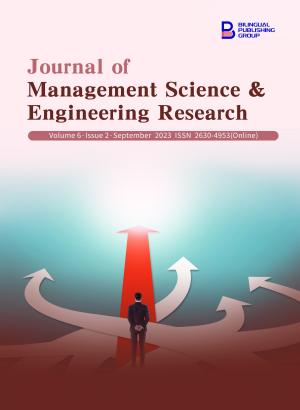-
5420
-
918
-
429
-
409
-
400
Back Bay Battery Simulation Reflective Essay
DOI:
https://doi.org/10.30564/jmser.v7i1.6002Abstract
The success of an organization’s innovation strategy relies on a clearly defined innovation theme. In this article, the author will delve into the concept of disruptive innovation and explore how to achieve Horizon 2 ideas. Horizon 2 ideas involve extending the business’s current model and core competencies to reach new customers, markets, and even new business objectives in different segments. The business model extension under Horizon 2 focuses on the organization’s mid-term goals, typically taking 24 to 36 months to yield results. Drawing insights from the Harvard Business Review’s Back Bay Battery (BBB) simulation, this article presents the implementation of an innovation strategy within the BBB company. The aim is to assist the company in enhancing its business model and transitioning into the high-end market. The latter part of the article will shed light on the challenges associated with implementing this strategy in a real-world firm and the results it can deliver to the organization. Specifically, it will explore the effectiveness of the strategy in achieving disruptive innovation within the employee market, where the company intends to use the new business model to tap into new markets.
Keywords:
Disruptive innovation; Horizon 2 idea; High-end marketReferences
[1] Strategic Innovation Simulation: Back Bay Battery [Internet]. Harvard Business School; 2008. Available from: https://www.hbs.edu/faculty/Pages/item.aspx?num=37262
[2] Stummer, C., Kiesling, E., 2021. An agent-based market simulation for enriching innovation management education. Central European Journal of Operations Research. 29(1), 143–161. DOI: https://doi.org/10.1007/s10100-020-00716-3
[3] Crespi, C., Laureiro-Martínez, D., Dodich, A., et al., 2018. Improving innovative decision-making: Training-induced changes in fronto-parietal networks. Brain and Cognition. 128, 46–55. DOI: https://doi.org/10.1016/j.bandc.2018.11.004
[4] Nagano, M.S., Stefanovitz, J.P., Vick, T.E., 2014. Innovation management processes, their internal organizational elements and contextual factors: An investigation in Brazil. Journal of Engineering and Technology Management. 33, 63–92. DOI: https://doi.org/10.1016/j.jengtecman.2014.02.004
[5] Si, S., Chen, H., 2020. A literature review of disruptive innovation: What it is, how it works and where it goes. Journal of Engineering and Technology Management. 56, 101568. DOI: https://doi.org/10.1016/j.jengtecman.2020.101568
[6] Sandberg, B., 2002. Creating the market for disruptive innovation: Market proactiveness at the launch stage. Journal of Targeting, Measurement and Analysis for Marketing. 11, 184–196. DOI: https://doi.org/10.1057/palgrave.jt.5740076
[7] Reinhardt, R., Gurtner, S., 2011. Enabling disruptive innovations through the use of customer analysis methods. Review of Managerial Science. 5, 291–307. DOI: https://doi.org/10.1007/s11846-011-0069-2
[8] Anthony, S.D., Johnson, M.W., Sinfield, J.V., et al., 2008. The innovator’s guide to growth: Putting disruptive innovation to work. Harvard Business Press: Harvard.
[9] Corso, M., Pellegrini, L., 2007. Continuous and discontinuous innovation: Overcoming the innovator dilemma. Creativity and Innovation Management. 16(4), 333–347. DOI: https://doi.org/10.1111/j.1467-8691.2007.00459.x
[10] Rebouillat, S., 2016. ARAMIDS: ‘disruptive’, open and continuous innovation. Advanced fibrous composite materials for ballistic protection. Woodhead Publishing: Sawston. pp. 11–70. DOI: https://doi.org/10.1016/B978-1-78242-461-1.00002-9
[11] Sánchez, F., Hartlieb, P., 2020. Innovation in the mining industry: Technological trends and a case study of the challenges of disruptive innovation. Mining, Metallurgy & Exploration. 37(5), 1385–1399. DOI: https://doi.org/10.1007/s42461-020-00262-1
[12] Christensen, C.M., McDonald, R., Altman, E.J., et al., 2018. Disruptive innovation: An intellectual history and directions for future research. Journal of Management Studies. 55(7), 1043–1078. DOI: https://doi.org/10.1111/joms.12349
[13] Osiyevskyy, O., Dewald, J., 2015. Explorative versus exploitative business model change: The cognitive antecedents of firm-level responses to disruptive innovation. Strategic Entrepreneurship Journal. 9(1), 58–78. DOI: https://doi.org/10.1002/sej.1192
[14] Dan, Y., Chieh, H.C. (editors), 2008. A reflective review of disruptive innovation theory. PICMET'08—2008 Portland International Conference on Management of Engineering & Technology; 2008 Jul 27–31; Cape Town, South Africa. New York: IEEE. p. 402–414. DOI: https://doi.org/10.1109/PICMET.2008.4599648
[15] Markides, C., 2006. Disruptive innovation: In need of better theory. Journal of Product Innovation Management. 23(1), 19–25.
[16] How Useful Is the Theory of Disruptive Innovation? [Internet]. MIT Sloan Management Review; 2015. Available from: https://sloanreview.mit.edu/article/how-useful-is-the-theory-of-disruptive-innovation/
[17] Christensen, C.M., Raynor, M.E., McDonald, R. What is disruptive innovation? Harvard Business Review, 2015 Dec. Available from: https://hbr.org/2015/12/what-is-disruptive-innovation
[18] Chandra, Y., Yang, S.J.S., 2011. Managing disruptive innovation: Entrepreneurial strategies and tournaments for corporate longevity. Journal of General Management. 37(2), 23–50. DOI: https://doi.org/10.1177/030630701103700202
[19] What Is Disruptive Innovation? [Internet]. Harvard Business Review. Available from: https://www.innosight.com/wp-content/uploads/2018/01/Innosight_HBR_What-is-Disruptive-Innovation.pdf
[20] Moore, G.A., 2007. To succeed in the long-term, focus on the middle-term. Harvard Business Review. 85(7–8), 84–90.
[21] Schmidt, G.M., Druehl, C.T., 2008. When is a disruptive innovation disruptive? Journal of Product Innovation Management. 25(4), 347–369. DOI: https://doi.org/10.1111/j.1540-5885.2008.00306.x
[22] Sundström, A., Hyder, A.S., Chowdhury, E.H., 2021. Market-oriented business model for SMEs' disruptive innovations internationalization. Marketing Intelligence & Planning. 39(5), 670–686. DOI: https://doi.org/10.1108/MIP-10-2019-0527
[23] The Challenges of Innovating for Sustainable Development [Internet]. MIT Sloan Management Review; 2003. Available from: https://sloanreview.mit.edu/article/the-challenges-of-innovating-for-sustainable-development/
[24] Nasiri, M., Tura, N., Ojanen, V. (editors), 2017. Developing disruptive innovations for sustainability: A review on Impact of Internet of Things (IOT). 2017 Portland International Conference on Management of Engineering and Technology (PICMET); 2017 Jul 9–13; Portland, OR, USA. New York: IEEE. p. 1–10. DOI: https://doi.org/10.23919/PICMET.2017.8125369
[25] Robertson, N., Luiz, J.M., 2019. Exploiting emerging market complementarities: Delayed, then accelerated internationalisation in a technology EMNE. Multinational Business Review. 27(1), 54–76. DOI: https://doi.org/10.1108/MBR-02-2018-0016
[26] Adner, R., 2012. The wide lens: A new strategy for innovation. Penguin: London.
[27] Kaltenecker, N., Hess, T., Huesig, S., 2015. Managing potentially disruptive innovations in software companies: Transforming from On-premises to the On-demand. The Journal of Strategic Information Systems. 24(4), 234–250. DOI: https://doi.org/10.1016/j.jsis.2015.08.006
[28] Helfat, C.E., Finkelstein, S., Mitchell, W., et al., 2009. Dynamic capabilities: Understanding strategic change in organizations. John Wiley & Sons: Hoboken.
Downloads
How to Cite
Issue
Article Type
License
Copyright © 2023 Author(s)

This is an open access article under the Creative Commons Attribution-NonCommercial 4.0 International (CC BY-NC 4.0) License.




 Tianyang Deng
Tianyang Deng






